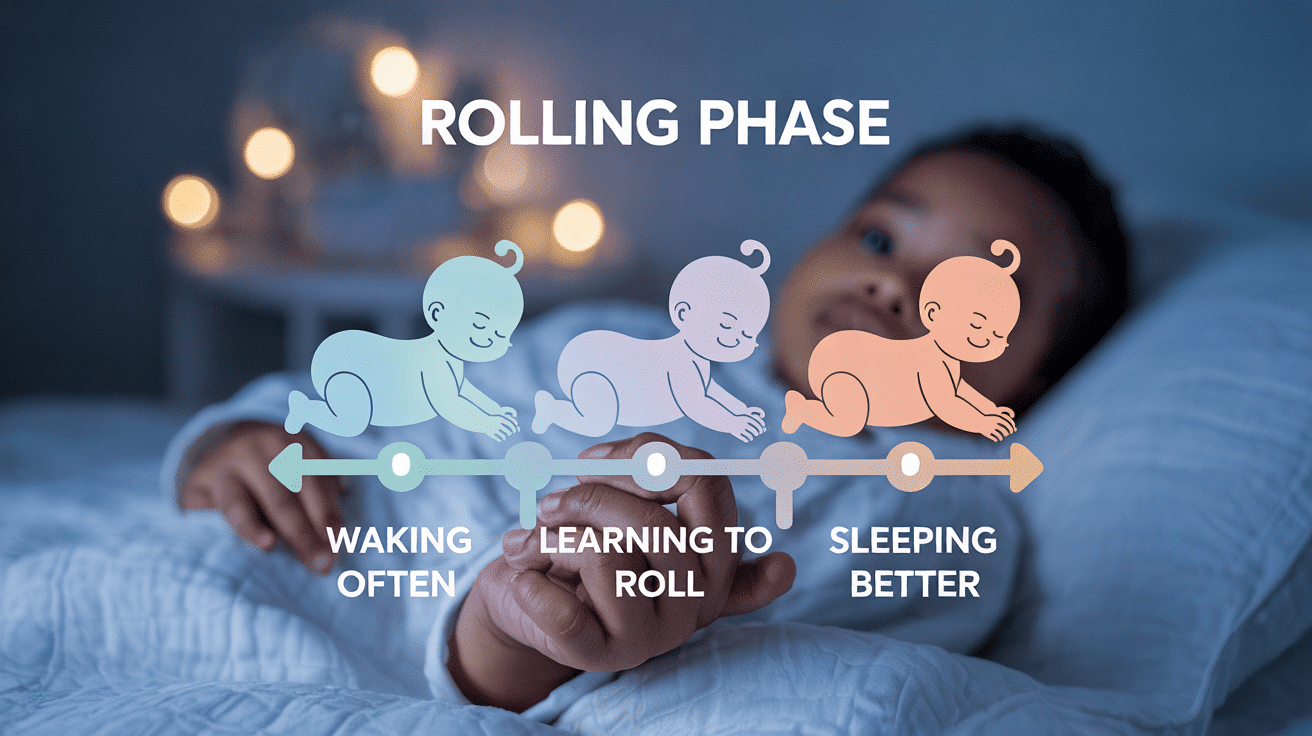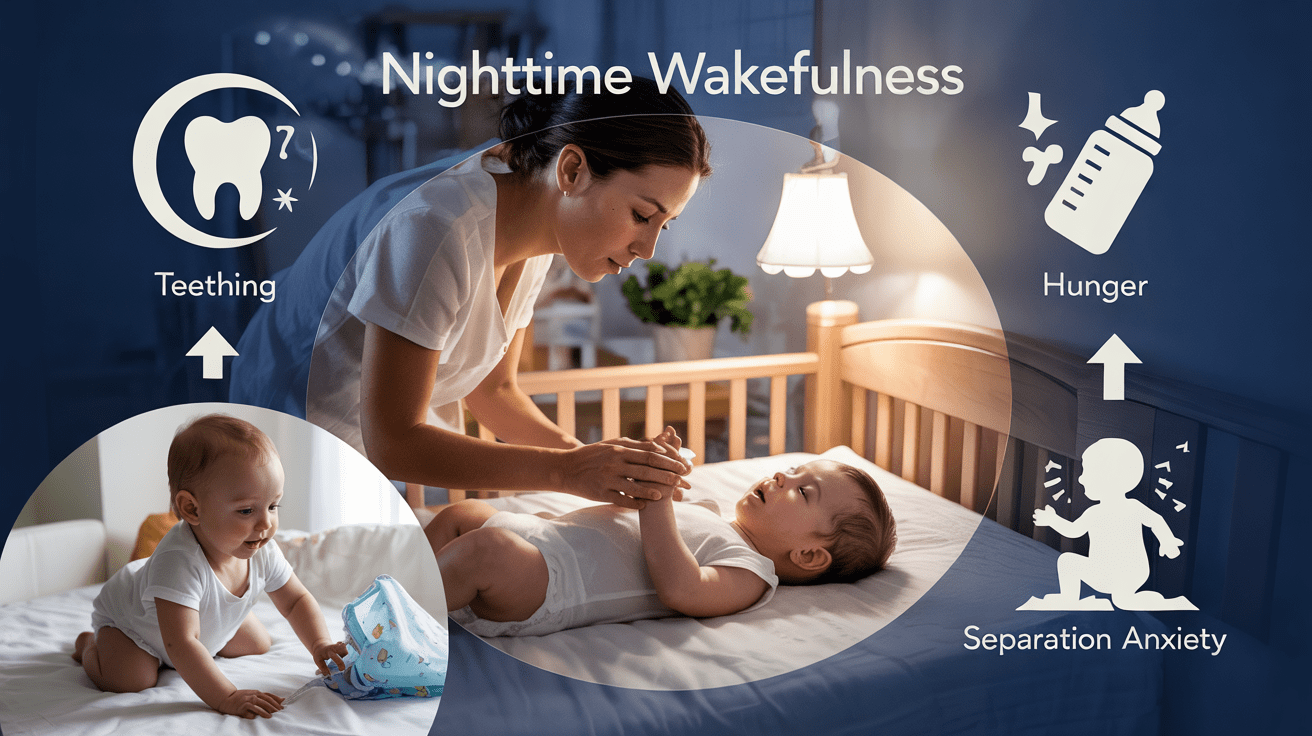
Is your once-perfect sleeper suddenly waking up in tears after rolling onto their tummy? You’re not alone!
The 4-6 month rolling milestone changes peaceful nights into frustrating wake-up marathons for countless parents.
This exciting developmental leap—where babies learn they can flip from back to tummy and eventually reverse—often creates the perfect storm for sleep disruptions.
When babies roll during sleep but can’t return to their preferred position, the midnight meltdowns begin! While exhausting, these wakings signal your baby’s brain is hard at work mastering crucial motor skills.
Do you know? Babies who practice rolling more during daytime play often master nighttime rolling faster, potentially shortening this sleep regression by up to a week!
Take heart—this challenging phase typically resolves within 2-4 weeks as your little gymnast perfects their rolling technique!
When Do Babies Start Rolling Over?
Most babies first roll from front to back between 4 and 5 months, with back-to-front rolling typically following around 5-6 months. However, some babies may begin as early as 3 months or as late as 7 months.
Signs that rolling is imminent include:
- Increased neck and upper body strength
- Successfully lifting head and chest during tummy time
- Pushing up on arms when on stomach
- Rocking from side to side
- Showing frustration when trying to reach toys just out of reach
Development varies significantly between babies. Premature infants may reach milestones later than full-term babies. Weight can also impact timing—heavier babies sometimes roll later, while more active babies often roll earlier.
Some babies skip rolling entirely, moving directly to sitting or crawling. Always provide a safe, supervised space for your baby to practice these new movements.
Why Rolling Causes Night Wakings?

When babies learn to roll, night-wakings often increase. Physical discomfort plays a significant role as babies may roll into positions they find uncomfortable but lack the skills to adjust themselves.
Many babies experience a startle response when unexpectedly rolling during sleep, instantly waking them.
A common frustration occurs when babies roll to their tummies but haven’t mastered rolling back, leaving them stuck in an unwanted position and crying for help. This predicament is particularly common between 4 and 6 months.
These sleep disruptions typically coincide with developmental leaps as the brain forms new neural connections supporting gross motor skills. The mental processing continues during sleep, causing partial wakings.
Most parents report that this phase is temporary and typically resolves within 2-3 weeks as babies become more comfortable with their new mobility.
Safe Sleep Practices For Rolling Babies

Once babies start rolling over, sleep safety becomes even more important. Following safe sleep practices can help reduce risks and support healthy sleep habits.
1. Crib Safety Considerations
Once your baby starts rolling, ensure the crib meets current safety standards with fixed sides and slats no more than 2⅜ inches apart. Remove all bumpers, pillows, blankets, stuffed animals, and toys from the sleep space. Lower the crib mattress to its lowest setting to prevent falls as your baby becomes more mobile.
2. Appropriate Sleep Surfaces
Use a firm, flat mattress with a fitted sheet only. Avoid inclined sleepers, swings, or soft surfaces for sleep. Portable cribs and bassinets are safe only until your baby shows signs of rolling or reaches the product’s weight limit.
3. Room Temperature and Clothing
Maintain a comfortable room temperature between 68-72°F (20-22°C). Dress your baby in one layer more than you would wear, typically a onesie with a sleep sack. Avoid overheating, which is a SIDS risk factor.
4. SIDS Prevention Guidelines for Mobile Babies
Always place your baby on their back to sleep initially, even if they can roll. Once they can roll independently both ways, you don’t need to reposition them if they roll during sleep.
Continue back-sleeping until 12 months. Keep the sleep area clear of hazards, maintain a smoke-free environment, and consider room-sharing (not bed-sharing) for the first 6-12 months.
How to Support Your Baby Through The Rolling Phase?

Supporting your baby’s rolling development requires consistent daytime practice. Provide ample supervised tummy time on a firm, flat surface with engaging toys positioned strategically to encourage rolling movements.
To help master back-to-front rolling, place toys slightly out of reach to motivate movement. For front-to-back rolling, gently guide your baby by lifting one arm overhead while talking encouragingly. Consistent practice helps babies learn to reposition themselves independently.
For nighttime wakings, keep a dim nightlight to help your baby orient themselves when they roll. If they wake frustrated, calmly reposition them while keeping interactions minimal to avoid fully waking them.
Remember that temporary sleep disruptions are normal during this phase. Most babies resolve rolling-related night-wakings within 2-3 weeks as their motor skills develop and they become comfortable with their new mobility.
How Long Does This Phase Last?

The rolling-related sleep disruption typically lasts 2-4 weeks for most babies. During this time, your baby is actively processing this new motor skill, both during waking hours and sleep.
Signs that your baby is adapting include decreased night-wakings, the ability to reposition itself when uncomfortable, less startling when rolling during sleep, and smoother transitions between positions.
Sleep usually improves once your baby can confidently roll in both directions and has developed the muscle memory to do so without fully waking.
Most parents notice significant improvement around the 3-week mark, though some babies adjust within days, while others may take up to 6 weeks.
When Tummy Sleep Becomes OK?

Tummy sleeping becomes safer once babies can confidently roll both ways independently and have adequate upper body strength to lift their heads and reposition themselves if needed—typically around 5-7 months of age.
However, even when this milestone is reached, you should always place your baby on their back at the start of sleep sessions.
If your baby rolls to their stomach during sleep and has the strength to push up on their arms, lift their head well, and roll back independently, most pediatricians agree you don’t need to reposition them. Their risk of breathing complications significantly decreases once they demonstrate these abilities.
Continue monitoring breathing by using a video monitor and ensuring the sleep surface remains firm and free of loose bedding.
Room-sharing until 6-12 months provides additional safety as you can quickly respond if your baby needs assistance repositioning.
Troubleshooting Persistent Wake-Ups

Frequent night wake-ups can be frustrating, but they often have simple causes. Understanding common triggers can help improve your baby’s sleep routine.
1. Additional Causes Beyond Rolling
While rolling development frequently triggers night-wakings, persistent disruptions may signal other issues. Teething discomfort often coincides with this developmental stage, causing additional pain-related wakings. Growth spurts around 4-6 months increase hunger, prompting night feedings.
Similarly, developmental leaps affect sleep as babies process new cognitive skills. Some babies experience separation anxiety during this period, waking more frequently to check for the caregiver’s presence.
2. Sleep Training Considerations
Many experts recommend pausing formal sleep training during the peak rolling phase, as babies genuinely need assistance repositioning. However, you can maintain sleep-supportive practices like consistent bedtimes, calming routines, and appropriate wake windows.
Once rolling skills are established, usually within 2-4 weeks, you can resume or begin structured sleep training if desired.
3. Maintaining Consistent Sleep Routines
Consistency becomes crucial during developmental transitions. Preserve bedtime rituals to signal sleep time despite disruptions. Keep interactions during night wakings brief and boring—offer minimal assistance with repositioning without introducing stimulating activities.
Consider temporarily extending daytime practice of rolling skills to build confidence. Ensure the last feeding is adequately filling, especially during growth spurts, to maximize sleep duration.
When to Consult a Professional?

While some sleep disruption during the rolling phase is normal, consult your pediatrician if your baby shows excessive distress during sleep, experiences persistent wakings lasting beyond 6 weeks after mastering rolling, or demonstrates changes in breathing patterns while sleeping.
Additional red flags include unusual daytime irritability, decreased appetite, or developmental regression in other areas. Your pediatrician can rule out medical causes like reflux, ear infections, or allergies that might exacerbate sleep issues.
They can also provide personalized guidance based on your baby’s health history. For additional support, consider certified pediatric sleep consultants, parent support groups, or evidence-based resources like the American Academy of Pediatrics’ sleep guidelines.
Closing Thoughts
As you experience the exhausting nights of helping your rolling baby resettle, remember that your consistent support is building your little one’s confidence in mastering this essential motor skill.
The midnight wake-ups and disrupted sleep schedules are undoubtedly challenging. Still, this phase is temporary and typically resolves within 2-4 weeks as your baby becomes more comfortable with their new mobility.
While it may not feel like it during those 3 AM wake-up calls, each roll represents an exciting developmental milestone worth celebrating.
Your baby is building crucial strength, coordination, and spatial awareness that will soon lead to sitting, crawling, and eventually walking.
Your patience during this transition is an investment in your baby’s development—before you know it, this challenging phase will be just another memory in your parenting phase.
If you’re interested in more informational content on mothers and babies, feel free to click here and explore other blogs that you might
